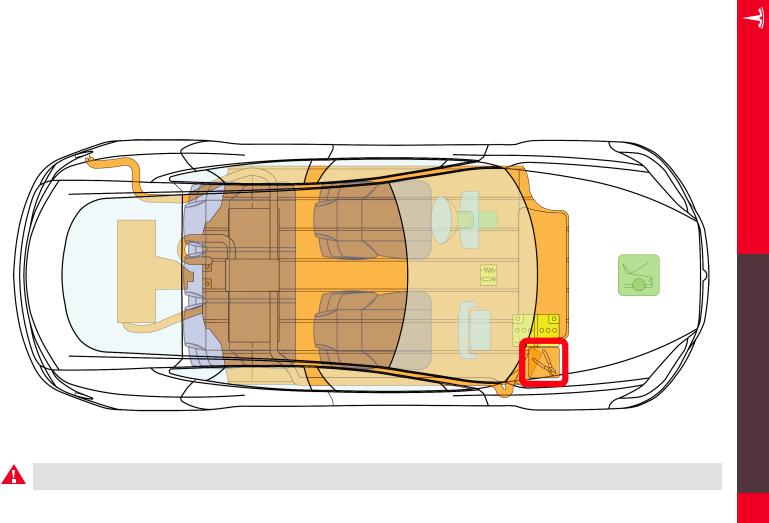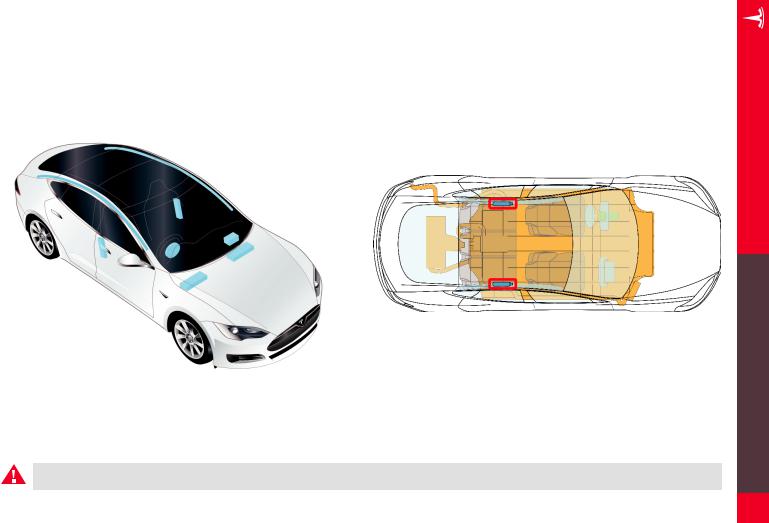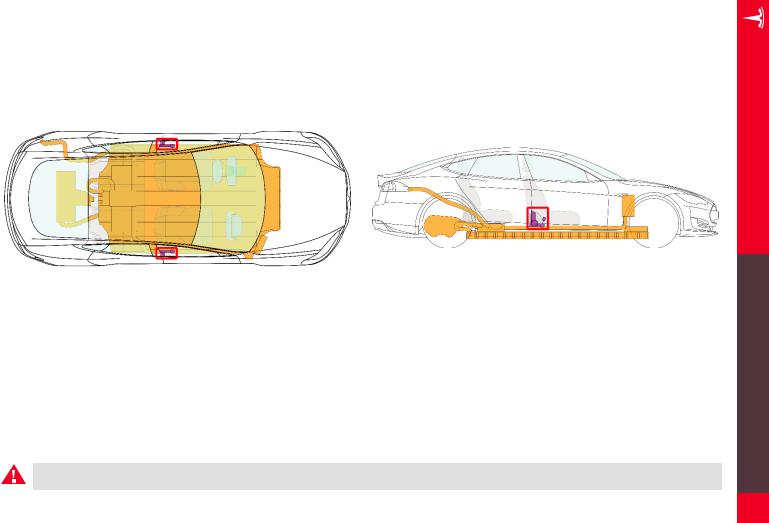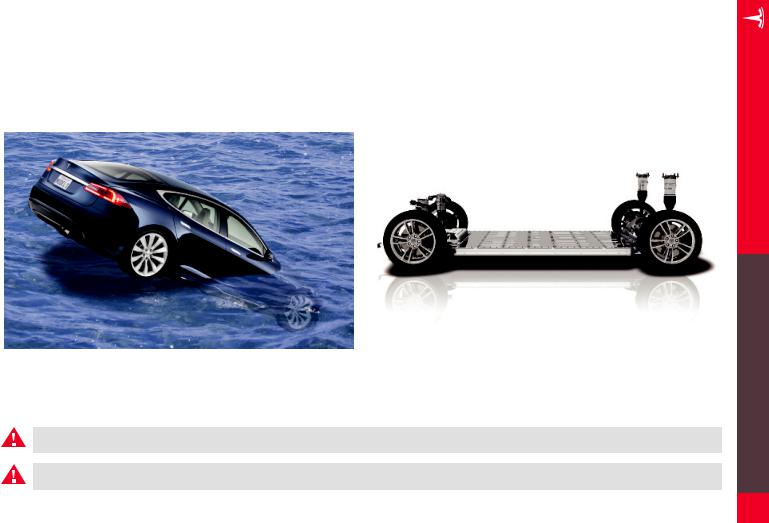
Tesla_ModelS_ERG
.PDF
12V BATTERY
In addition to the high voltage system, Model S has a low voltage system, powered by a traditional 12 volt battery. The low voltage system operates the same electrical components found in conventional vehicles, including the supplementary restraint system (SRS), airbags, ignition, touchscreen, and interior and exterior lights.
The low voltage system interacts with the high voltage system. The DC-DC converter supplies the 12V battery with power to support low voltage functions, and the 12V battery supplies power to the high voltage contacts to allow power to flow out of the high voltage battery.
12V battery is located on the passenger side, under the hood and the plastic access panel
WARNING: Regardless of the disabling procedure you use, ALWAYS ASSUME THAT ALL HIGH VOLTAGE COMPONENTS ARE ENERGIZED! Cutting, crushing or touching high voltage components can result in serious injury or death.
GUIDE RESPONSE EMERGENCY
SYSTEM VOLTAGE LOW
9

FIRST RESPONDER CUT LOOP
The first responder cut loop consists of low voltage wires. Cutting this loop shuts down the high voltage system and disables the SRS and airbag components. See cut instructions on page 11.
NOTE: When cutting the loop, double cut to remove an entire section. This eliminates the risk of the cut wires accidentally reconnecting.
Cut loop is located on the passenger side, under the hood and the plastic access panel
WARNING: Regardless of the disabling procedure you use, ALWAYS ASSUME THAT ALL HIGH VOLTAGE COMPONENTS ARE ENERGIZED! Cutting, crushing or touching high voltage components can result in serious injury or death.
GUIDE RESPONSE EMERGENCY
HIGH DISABLING VOLTAGE
10

CUTTING THE FIRST RESPONDER LOOP
STEP 1: Open the hood (also known as the Front Trunk). See page 21 for details.
The cut loop is located on the passenger side. Its label protrudes from under the plastic access panel.
Cut loop label
STEP 2: Remove the access panel by pulling its rear edge upward to release the five clips that hold it in place. Maneuver it toward the windshield to remove.
Remove access panel
STEP 3: DOUBLE CUT the loop to remove an entire section.
Removing an entire section of the cut loop eliminates the risk of the wires accidentally touching (reconnecting).
Double cut the loop
WARNING: Regardless of the disabling procedure you use, ALWAYS ASSUME THAT ALL HIGH VOLTAGE COMPONENTS ARE ENERGIZED! Cutting, crushing or touching high voltage components can result in serious injury or death.
GUIDE RESPONSE EMERGENCY
HIGH DISABLING VOLTAGE
11

STABILIZING MODEL S
CHOCK ALL FOUR WHEELS
Drivers can choose a setting that determines whether or not Model S will
“creep” when a driving gear is selected. If this setting is off, Model S does not move unless the accelerator is pressed, even if shifted into Drive or
Reverse. Therefore, never assume that Model S will not move. Always chock the wheels.
SHIFT INTO PARK
Model S is silent so never assume it is powered off. Pressing the accelerator pedal even slightly can cause Model S to move quickly if the currently active gear is Drive or Reverse. To ensure that the parking brake is engaged, press the button on the end of the gear selector to shift into Park. Whenever Model S is in Park, the parking brake is automatically engaged.
WARNING: Regardless of the disabling procedure you use, ALWAYS ASSUME THAT ALL HIGH VOLTAGE COMPONENTS ARE ENERGIZED! Cutting, crushing or touching high voltage components can result in serious injury or death.
GUIDE RESPONSE EMERGENCY
S MODEL STABILIZING
12

AIRBAGS
Model S is equipped with eight airbags. Responders should de-energize the airbags by cutting the First Responder Cut Loop (see page 11). Airbags are shown below in blue.
AIRBAG INFLATION CYLINDERS
Airbag (stored gas) inflation cylinders are located toward the rear of the vehicle, as shown below in red.
GUIDE RESPONSE EMERGENCY
Airbag inflation cylinders are located toward the rear
WARNING: Regardless of the disabling procedure you use, ALWAYS ASSUME THAT ALL HIGH VOLTAGE COMPONENTS ARE ENERGIZED! Cutting, crushing or touching high voltage components can result in serious injury or death.
SRS AND AIRBAGS
13

SEAT BELT PRE-TENSIONERS
Seat belt pre-tensioners are located by the B-pillars, as shown below in red.
Seat belt pre-tensioners are located by the B-pillars
WARNING: Regardless of the disabling procedure you use, ALWAYS ASSUME THAT ALL HIGH VOLTAGE COMPONENTS ARE ENERGIZED! Cutting, crushing or touching high voltage components can result in serious injury or death.
GUIDE RESPONSE EMERGENCY
SRS AND AIRBAGS
14

LOCATION OF REINFORCEMENTS AND HIGH STRENGTH STEEL
Model S is reinforced to protect occupants in a collision. Reinforcements are shown below in green.
Only the B-pillars are reinforced with high strength steel. Depending on the tools used, high strength steel can be challenging or impossible to cut. If necessary, use workaround techniques.
Only the B-pillars are reinforced with high strength steel
WARNING: Always use appropriate tools (such as a hydraulic cutter), and always wear appropriate Personal Protective Equipment (PPE) when cutting Model S. Failure to follow these instructions can result in serious injury or death.
WARNING: Regardless of the disabling procedure you use, ALWAYS ASSUME THAT ALL HIGH VOLTAGE COMPONENTS ARE ENERGIZED! Cutting, crushing or touching high voltage components can result in serious injury or death.
GUIDE RESPONSE EMERGENCY
STEEL STENGTH HIGH
15

NO-CUT ZONES
Model S has areas that are defined as “no-cut zones” due to high voltage, gas struts, and SRS or airbag hazards. Never cut or crush these areas—doing so can result in serious injury or death.
GUIDE RESPONSE EMERGENCY
Do not cut through areas shown in red
WARNING: Always use appropriate tools (such as a hydraulic cutter), and always wear appropriate Personal Protective Equipment (PPE) when cutting Model S. Failure to follow these instructions can result in serious injury or death.
WARNING: Regardless of the disabling procedure you use, ALWAYS ASSUME THAT ALL HIGH VOLTAGE COMPONENTS ARE ENERGIZED! Cutting, crushing or touching high voltage components can result in serious injury or death.
ZONES CUT NO
16

FULLY OR PARTIALLY SUBMERGED VEHICLES
Treat a submerged Model S like any other vehicle. The body of the vehicle does not present a risk of shock in water. Remove the vehicle from the water and continue with normal high voltage disabling.
PUSHING ON THE FLOOR PAN
The high voltage battery is located below the floor pan. Never push down on the floor pan from inside Model S. Doing so can breach the high voltage battery, which can cause serious injury or death.
WARNING: Failure to handle a submerged vehicle without appropriate PPE can result in serious injury or death.
WARNING: Regardless of the disabling procedure you use, ALWAYS ASSUME THAT ALL HIGH VOLTAGE COMPONENTS ARE ENERGIZED! Cutting, crushing or touching high voltage components can result in serious injury or death.
GUIDE RESPONSE EMERGENCY
OPERATIONS RESCUE
17

FIREFIGHTING |
HIGH VOLTAGE BATTERY - FIRE DAMAGE |
Extinguish small fires, that do not involve the high voltage battery, using a
CO2 or ABC extinguisher.
During overhaul, do not make contact with any high voltage component. Always use insulated tools for overhaul.
Stored gas inflation cylinders, gas struts, and other components can BLEVE (Boiling Liquid Expanding Vapor Explosion) in extreme temperatures. Perform an adequate “knock down” on the fire before entering the incident’s “hot zone.”
If the high voltage battery becomes involved in fire or is bent, twisted, damaged, or breached in any way, or if you suspect that the battery is heating, use large amounts of water to cool the battery. DO NOT extinguish fire with a small amount of water. Always establish or request an additional water supply.
Battery fires can take up to 24 hours to fully extinguish. Consider allowing the vehicle to burn while protecting exposures.
Use a thermal imaging camera to ensure the high voltage battery is completely cooled before leaving the incident. If a thermal imaging camera is not available, you must monitor the battery for re-ignition. Smoke indicates that the battery is still heating. Do not release the vehicle to second responders until there has been no sign of smoke from the battery for at least one hour.
Always advise second responders (law enforcement, tow personnel) that there is a risk of the battery re-igniting. After a Model S has been involved in a submersion, fire, or a collision that has compromised the high voltage battery, always store it in an open area with no exposures within 50 feet.
A burning or heating battery releases toxic vapors. These vapors include
H2SO4, oxides of carbon, nickel, aluminum, lithium, copper, and cobalt. Responders should wear full PPE, including SCBA, and take appropriate measures to protect civilians downwind from the incident. Use fog streams or PPV (Positive Pressure Ventilation) fans to direct vapors.
The high voltage battery consists of lithium-ion cells. These are considered dry cell batteries. If damaged, only a small amount of battery fluid can leak. Lithium-ion battery fluid is clear in color.
The high voltage battery, the drive unit, the charge controllers, and the
DC-DC converter are liquid cooled with typical glycol-based coolant. If damaged, blue fluid can leak out of the battery.
A damaged high voltage battery can cause rapid heating of the battery cells. If you notice smoke coming from the battery area, assume the battery is heating and take appropriate action as described under the heading “FIREFIGHTING” on this page.
WARNING: When fire is involved, consider the entire vehicle energized and DO NOT TOUCH any part of the vehicle. Always wear full PPE (Personal Protective Equipment), including SCBA (Self-Contained Breathing Apparatus).
WARNING: Regardless of the disabling procedure you use, ALWAYS ASSUME THAT ALL HIGH VOLTAGE COMPONENTS ARE ENERGIZED! Cutting, crushing or touching high voltage components can result in serious injury or death.
GUIDE RESPONSE EMERGENCY
OPERATIONS RESCUE
18
